ACCG 925 - Auditing and Assurance: A Detailed Report on Standards
VerifiedAdded on 2022/11/13
|9
|1471
|201
Report
AI Summary
This report provides a detailed analysis of auditing and assurance services, focusing on the evolution of auditing reports and the changes in reporting standards over the years. It highlights the similarities and differences between the IIASB and PCAOB standards across various categories and audit matters. The report explains the reasons and motivations behind the changes in audit reporting, illustrating the evolution with a diagram. It also examines the impact of these changes on auditor practices, particularly focusing on the introduction of Key Audit Matters (KAM) and Critical Audit Matters (CAM). The analysis covers the implications for financial reporting, transparency, and communication between auditors and stakeholders, ultimately concluding that the changes have had a positive impact on the auditing profession by improving the quality and clarity of audit reports.
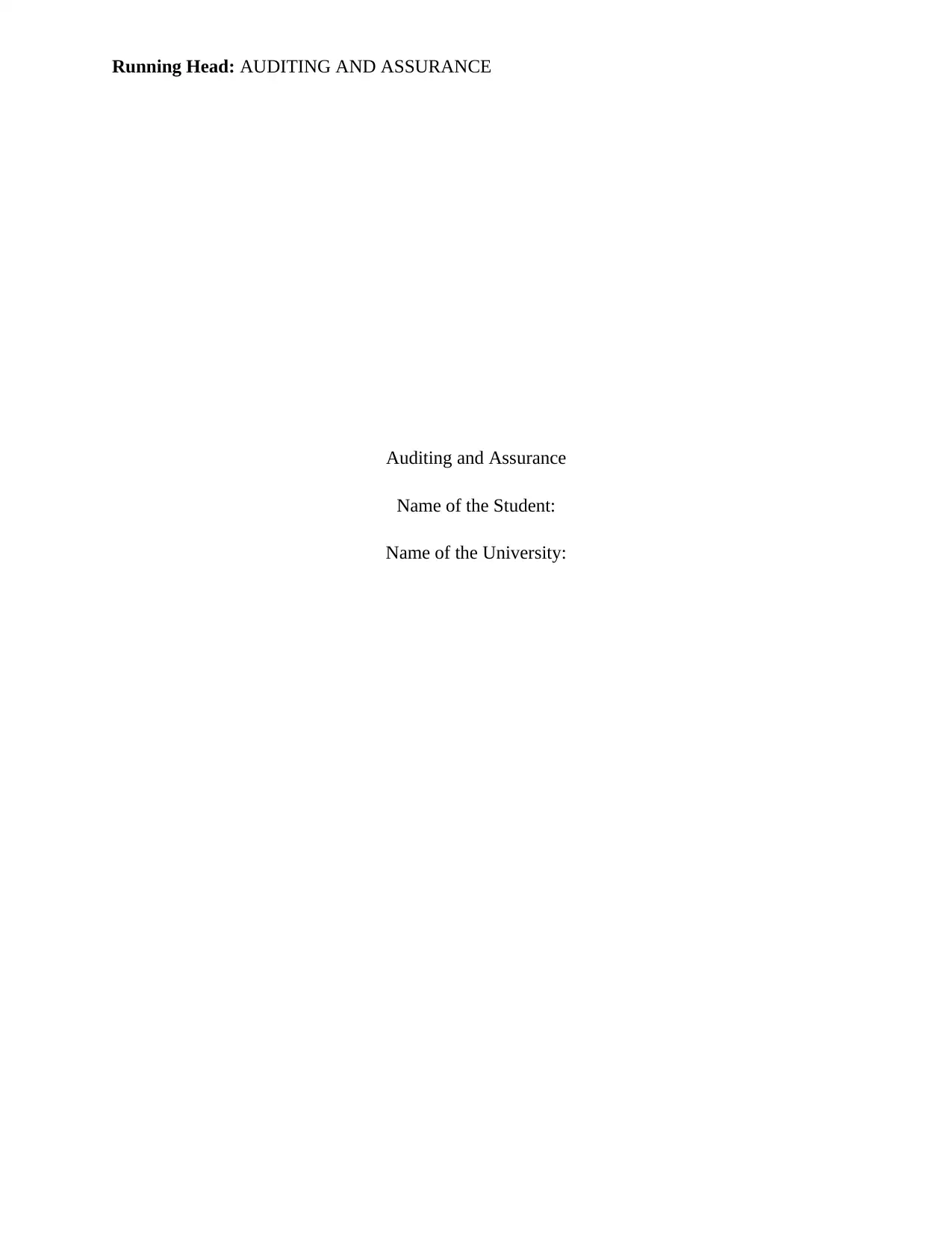
Running Head: AUDITING AND ASSURANCE
Auditing and Assurance
Name of the Student:
Name of the University:
Auditing and Assurance
Name of the Student:
Name of the University:
Paraphrase This Document
Need a fresh take? Get an instant paraphrase of this document with our AI Paraphraser
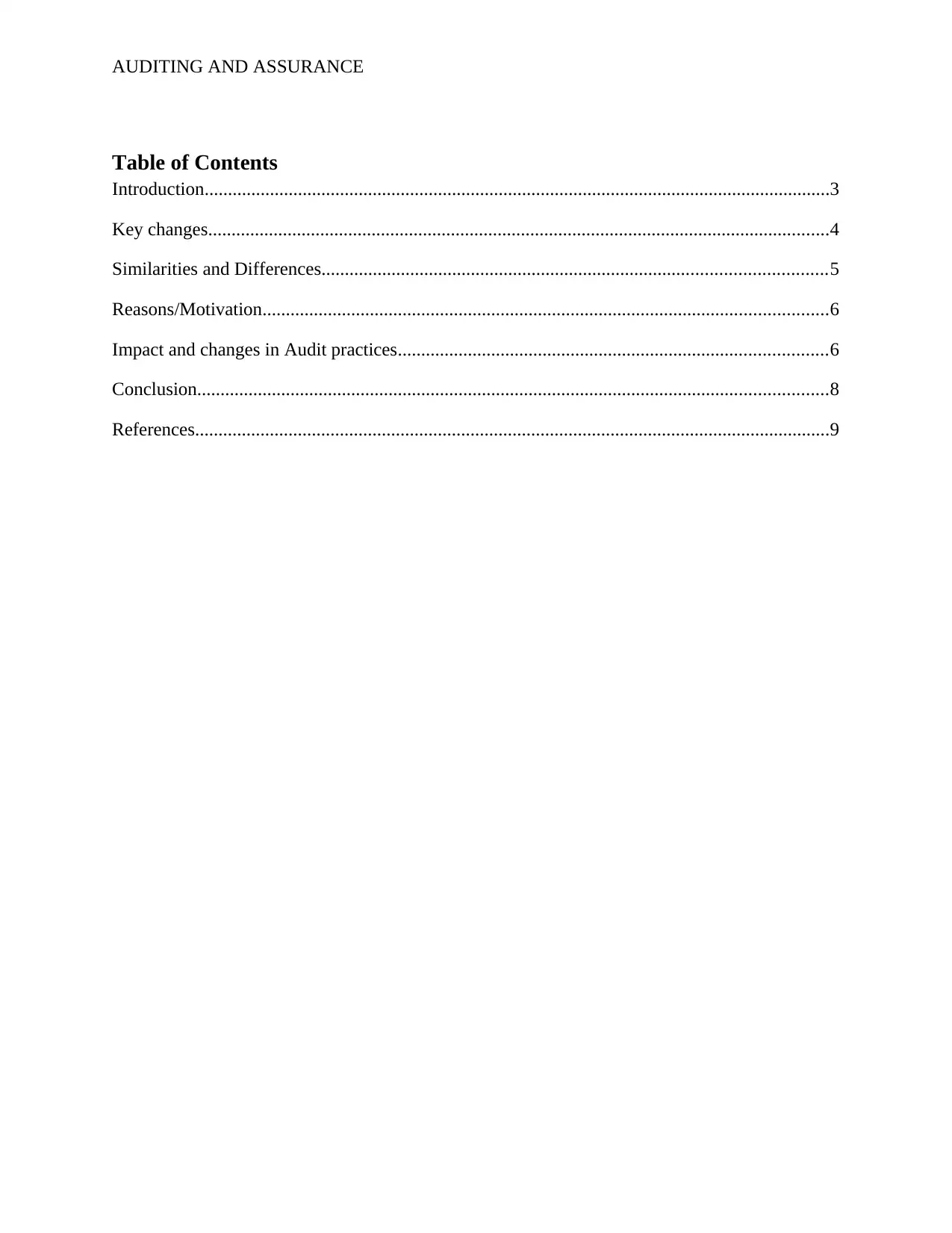
AUDITING AND ASSURANCE
Table of Contents
Introduction......................................................................................................................................3
Key changes.....................................................................................................................................4
Similarities and Differences............................................................................................................5
Reasons/Motivation.........................................................................................................................6
Impact and changes in Audit practices............................................................................................6
Conclusion.......................................................................................................................................8
References........................................................................................................................................9
Table of Contents
Introduction......................................................................................................................................3
Key changes.....................................................................................................................................4
Similarities and Differences............................................................................................................5
Reasons/Motivation.........................................................................................................................6
Impact and changes in Audit practices............................................................................................6
Conclusion.......................................................................................................................................8
References........................................................................................................................................9
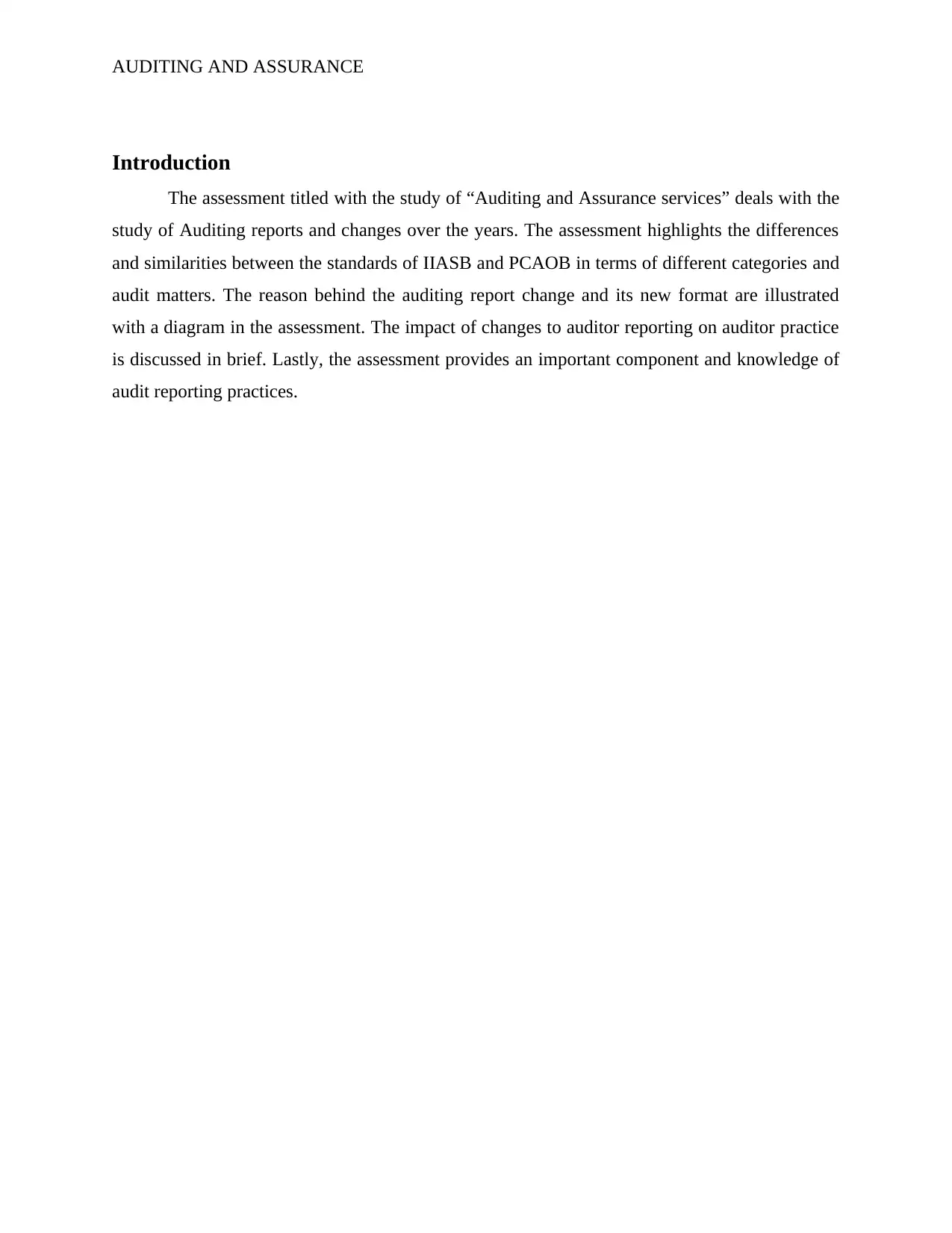
AUDITING AND ASSURANCE
Introduction
The assessment titled with the study of “Auditing and Assurance services” deals with the
study of Auditing reports and changes over the years. The assessment highlights the differences
and similarities between the standards of IIASB and PCAOB in terms of different categories and
audit matters. The reason behind the auditing report change and its new format are illustrated
with a diagram in the assessment. The impact of changes to auditor reporting on auditor practice
is discussed in brief. Lastly, the assessment provides an important component and knowledge of
audit reporting practices.
Introduction
The assessment titled with the study of “Auditing and Assurance services” deals with the
study of Auditing reports and changes over the years. The assessment highlights the differences
and similarities between the standards of IIASB and PCAOB in terms of different categories and
audit matters. The reason behind the auditing report change and its new format are illustrated
with a diagram in the assessment. The impact of changes to auditor reporting on auditor practice
is discussed in brief. Lastly, the assessment provides an important component and knowledge of
audit reporting practices.
⊘ This is a preview!⊘
Do you want full access?
Subscribe today to unlock all pages.

Trusted by 1+ million students worldwide
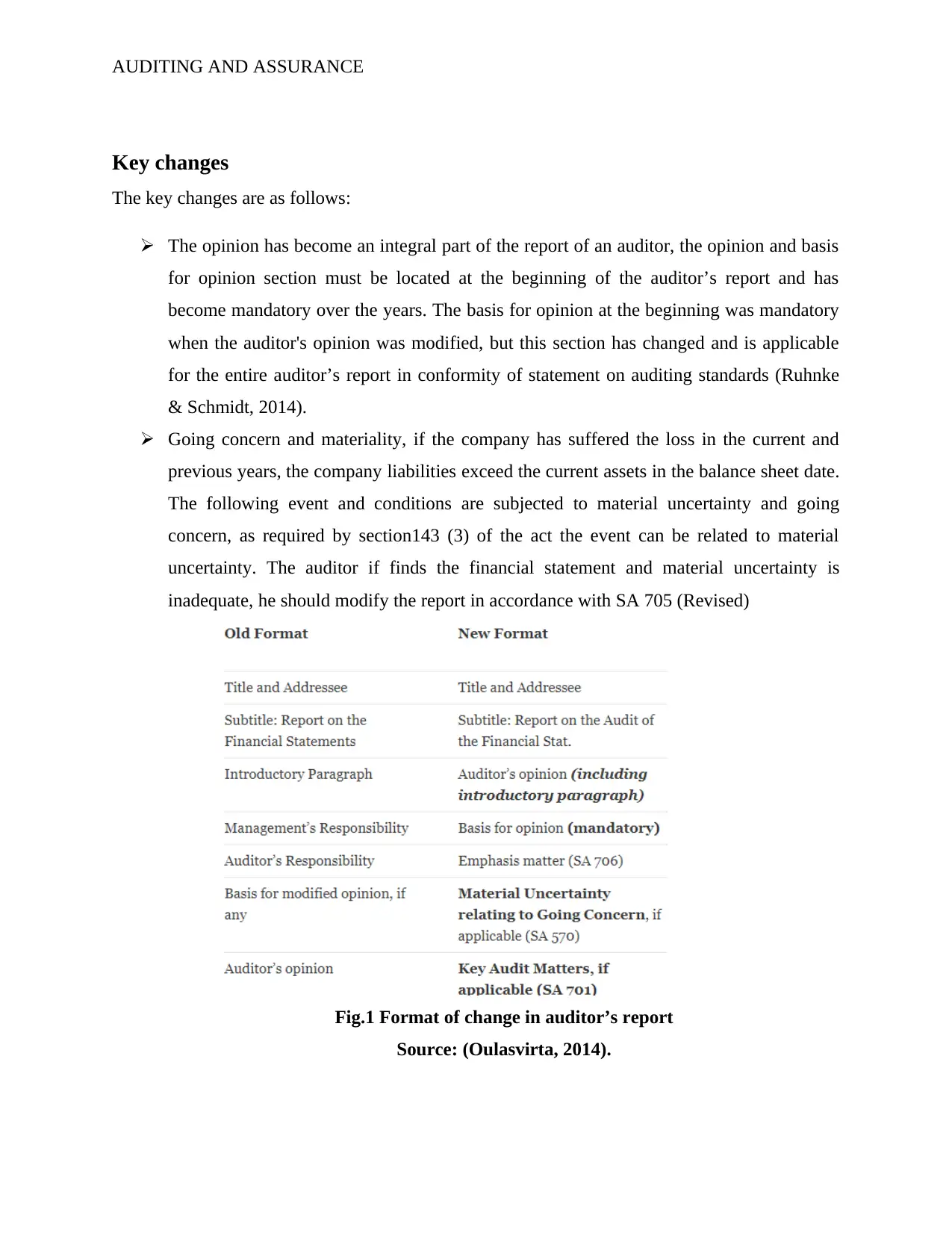
AUDITING AND ASSURANCE
Key changes
The key changes are as follows:
The opinion has become an integral part of the report of an auditor, the opinion and basis
for opinion section must be located at the beginning of the auditor’s report and has
become mandatory over the years. The basis for opinion at the beginning was mandatory
when the auditor's opinion was modified, but this section has changed and is applicable
for the entire auditor’s report in conformity of statement on auditing standards (Ruhnke
& Schmidt, 2014).
Going concern and materiality, if the company has suffered the loss in the current and
previous years, the company liabilities exceed the current assets in the balance sheet date.
The following event and conditions are subjected to material uncertainty and going
concern, as required by section143 (3) of the act the event can be related to material
uncertainty. The auditor if finds the financial statement and material uncertainty is
inadequate, he should modify the report in accordance with SA 705 (Revised)
Fig.1 Format of change in auditor’s report
Source: (Oulasvirta, 2014).
Key changes
The key changes are as follows:
The opinion has become an integral part of the report of an auditor, the opinion and basis
for opinion section must be located at the beginning of the auditor’s report and has
become mandatory over the years. The basis for opinion at the beginning was mandatory
when the auditor's opinion was modified, but this section has changed and is applicable
for the entire auditor’s report in conformity of statement on auditing standards (Ruhnke
& Schmidt, 2014).
Going concern and materiality, if the company has suffered the loss in the current and
previous years, the company liabilities exceed the current assets in the balance sheet date.
The following event and conditions are subjected to material uncertainty and going
concern, as required by section143 (3) of the act the event can be related to material
uncertainty. The auditor if finds the financial statement and material uncertainty is
inadequate, he should modify the report in accordance with SA 705 (Revised)
Fig.1 Format of change in auditor’s report
Source: (Oulasvirta, 2014).
Paraphrase This Document
Need a fresh take? Get an instant paraphrase of this document with our AI Paraphraser
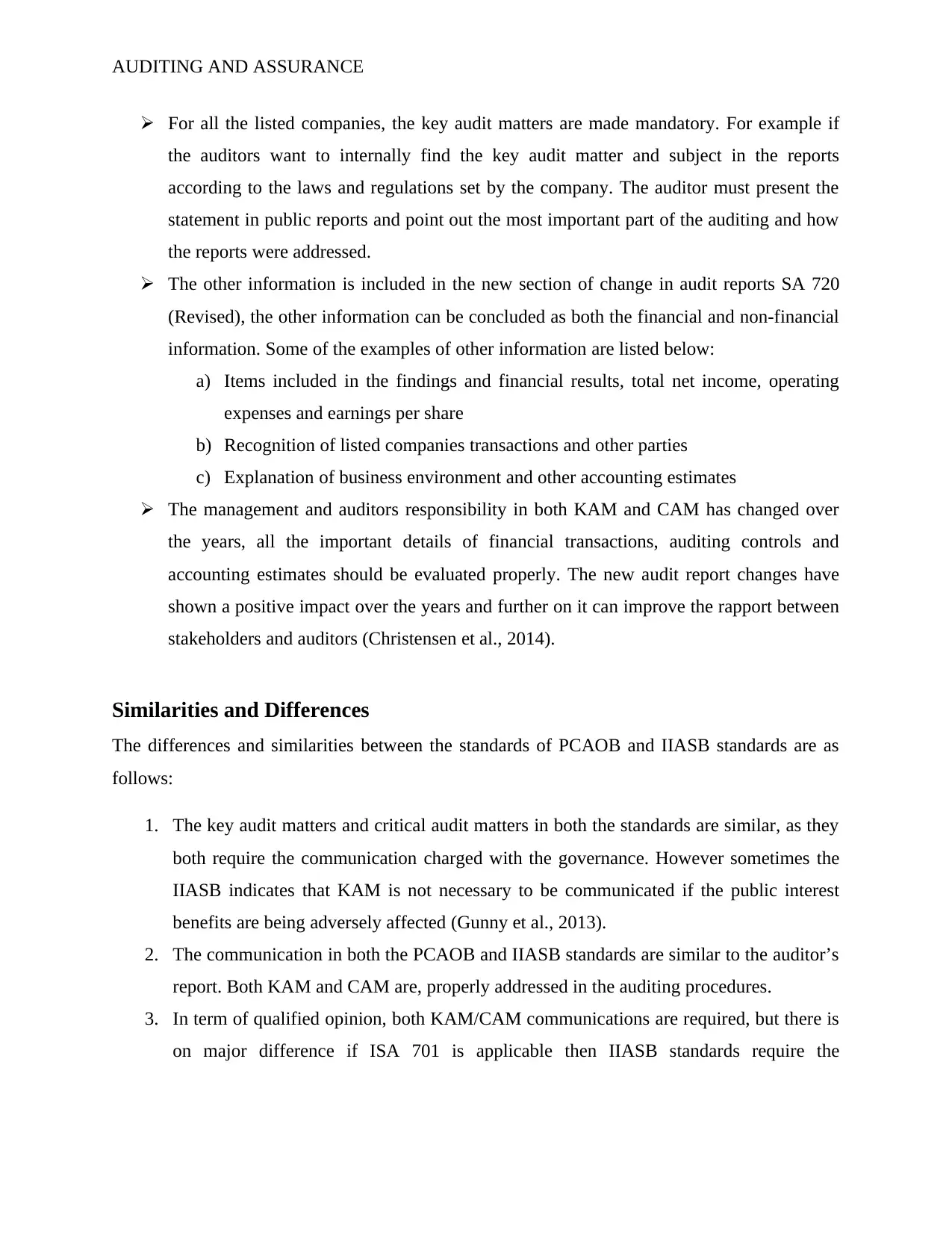
AUDITING AND ASSURANCE
For all the listed companies, the key audit matters are made mandatory. For example if
the auditors want to internally find the key audit matter and subject in the reports
according to the laws and regulations set by the company. The auditor must present the
statement in public reports and point out the most important part of the auditing and how
the reports were addressed.
The other information is included in the new section of change in audit reports SA 720
(Revised), the other information can be concluded as both the financial and non-financial
information. Some of the examples of other information are listed below:
a) Items included in the findings and financial results, total net income, operating
expenses and earnings per share
b) Recognition of listed companies transactions and other parties
c) Explanation of business environment and other accounting estimates
The management and auditors responsibility in both KAM and CAM has changed over
the years, all the important details of financial transactions, auditing controls and
accounting estimates should be evaluated properly. The new audit report changes have
shown a positive impact over the years and further on it can improve the rapport between
stakeholders and auditors (Christensen et al., 2014).
Similarities and Differences
The differences and similarities between the standards of PCAOB and IIASB standards are as
follows:
1. The key audit matters and critical audit matters in both the standards are similar, as they
both require the communication charged with the governance. However sometimes the
IIASB indicates that KAM is not necessary to be communicated if the public interest
benefits are being adversely affected (Gunny et al., 2013).
2. The communication in both the PCAOB and IIASB standards are similar to the auditor’s
report. Both KAM and CAM are, properly addressed in the auditing procedures.
3. In term of qualified opinion, both KAM/CAM communications are required, but there is
on major difference if ISA 701 is applicable then IIASB standards require the
For all the listed companies, the key audit matters are made mandatory. For example if
the auditors want to internally find the key audit matter and subject in the reports
according to the laws and regulations set by the company. The auditor must present the
statement in public reports and point out the most important part of the auditing and how
the reports were addressed.
The other information is included in the new section of change in audit reports SA 720
(Revised), the other information can be concluded as both the financial and non-financial
information. Some of the examples of other information are listed below:
a) Items included in the findings and financial results, total net income, operating
expenses and earnings per share
b) Recognition of listed companies transactions and other parties
c) Explanation of business environment and other accounting estimates
The management and auditors responsibility in both KAM and CAM has changed over
the years, all the important details of financial transactions, auditing controls and
accounting estimates should be evaluated properly. The new audit report changes have
shown a positive impact over the years and further on it can improve the rapport between
stakeholders and auditors (Christensen et al., 2014).
Similarities and Differences
The differences and similarities between the standards of PCAOB and IIASB standards are as
follows:
1. The key audit matters and critical audit matters in both the standards are similar, as they
both require the communication charged with the governance. However sometimes the
IIASB indicates that KAM is not necessary to be communicated if the public interest
benefits are being adversely affected (Gunny et al., 2013).
2. The communication in both the PCAOB and IIASB standards are similar to the auditor’s
report. Both KAM and CAM are, properly addressed in the auditing procedures.
3. In term of qualified opinion, both KAM/CAM communications are required, but there is
on major difference if ISA 701 is applicable then IIASB standards require the
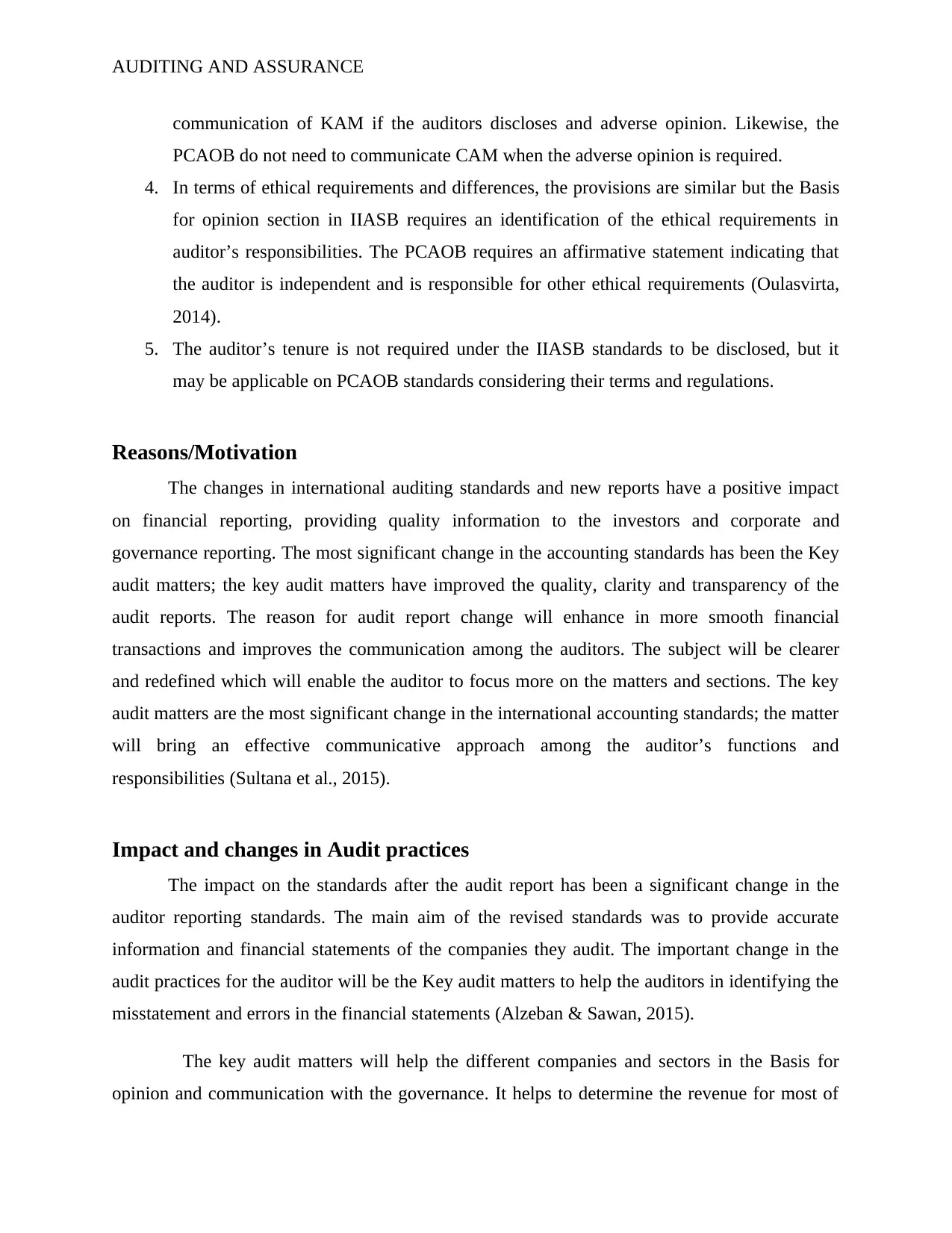
AUDITING AND ASSURANCE
communication of KAM if the auditors discloses and adverse opinion. Likewise, the
PCAOB do not need to communicate CAM when the adverse opinion is required.
4. In terms of ethical requirements and differences, the provisions are similar but the Basis
for opinion section in IIASB requires an identification of the ethical requirements in
auditor’s responsibilities. The PCAOB requires an affirmative statement indicating that
the auditor is independent and is responsible for other ethical requirements (Oulasvirta,
2014).
5. The auditor’s tenure is not required under the IIASB standards to be disclosed, but it
may be applicable on PCAOB standards considering their terms and regulations.
Reasons/Motivation
The changes in international auditing standards and new reports have a positive impact
on financial reporting, providing quality information to the investors and corporate and
governance reporting. The most significant change in the accounting standards has been the Key
audit matters; the key audit matters have improved the quality, clarity and transparency of the
audit reports. The reason for audit report change will enhance in more smooth financial
transactions and improves the communication among the auditors. The subject will be clearer
and redefined which will enable the auditor to focus more on the matters and sections. The key
audit matters are the most significant change in the international accounting standards; the matter
will bring an effective communicative approach among the auditor’s functions and
responsibilities (Sultana et al., 2015).
Impact and changes in Audit practices
The impact on the standards after the audit report has been a significant change in the
auditor reporting standards. The main aim of the revised standards was to provide accurate
information and financial statements of the companies they audit. The important change in the
audit practices for the auditor will be the Key audit matters to help the auditors in identifying the
misstatement and errors in the financial statements (Alzeban & Sawan, 2015).
The key audit matters will help the different companies and sectors in the Basis for
opinion and communication with the governance. It helps to determine the revenue for most of
communication of KAM if the auditors discloses and adverse opinion. Likewise, the
PCAOB do not need to communicate CAM when the adverse opinion is required.
4. In terms of ethical requirements and differences, the provisions are similar but the Basis
for opinion section in IIASB requires an identification of the ethical requirements in
auditor’s responsibilities. The PCAOB requires an affirmative statement indicating that
the auditor is independent and is responsible for other ethical requirements (Oulasvirta,
2014).
5. The auditor’s tenure is not required under the IIASB standards to be disclosed, but it
may be applicable on PCAOB standards considering their terms and regulations.
Reasons/Motivation
The changes in international auditing standards and new reports have a positive impact
on financial reporting, providing quality information to the investors and corporate and
governance reporting. The most significant change in the accounting standards has been the Key
audit matters; the key audit matters have improved the quality, clarity and transparency of the
audit reports. The reason for audit report change will enhance in more smooth financial
transactions and improves the communication among the auditors. The subject will be clearer
and redefined which will enable the auditor to focus more on the matters and sections. The key
audit matters are the most significant change in the international accounting standards; the matter
will bring an effective communicative approach among the auditor’s functions and
responsibilities (Sultana et al., 2015).
Impact and changes in Audit practices
The impact on the standards after the audit report has been a significant change in the
auditor reporting standards. The main aim of the revised standards was to provide accurate
information and financial statements of the companies they audit. The important change in the
audit practices for the auditor will be the Key audit matters to help the auditors in identifying the
misstatement and errors in the financial statements (Alzeban & Sawan, 2015).
The key audit matters will help the different companies and sectors in the Basis for
opinion and communication with the governance. It helps to determine the revenue for most of
⊘ This is a preview!⊘
Do you want full access?
Subscribe today to unlock all pages.

Trusted by 1+ million students worldwide
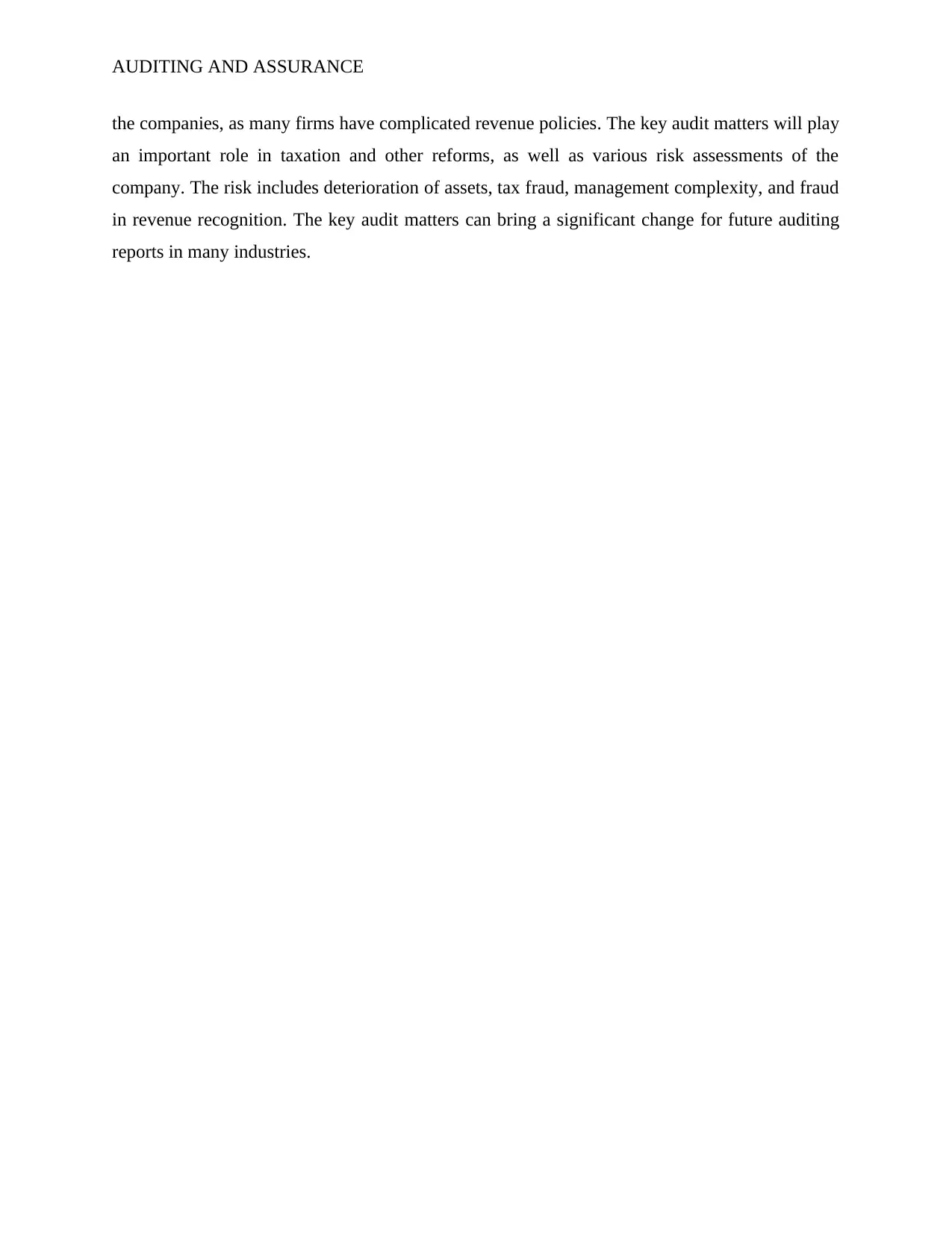
AUDITING AND ASSURANCE
the companies, as many firms have complicated revenue policies. The key audit matters will play
an important role in taxation and other reforms, as well as various risk assessments of the
company. The risk includes deterioration of assets, tax fraud, management complexity, and fraud
in revenue recognition. The key audit matters can bring a significant change for future auditing
reports in many industries.
the companies, as many firms have complicated revenue policies. The key audit matters will play
an important role in taxation and other reforms, as well as various risk assessments of the
company. The risk includes deterioration of assets, tax fraud, management complexity, and fraud
in revenue recognition. The key audit matters can bring a significant change for future auditing
reports in many industries.
Paraphrase This Document
Need a fresh take? Get an instant paraphrase of this document with our AI Paraphraser
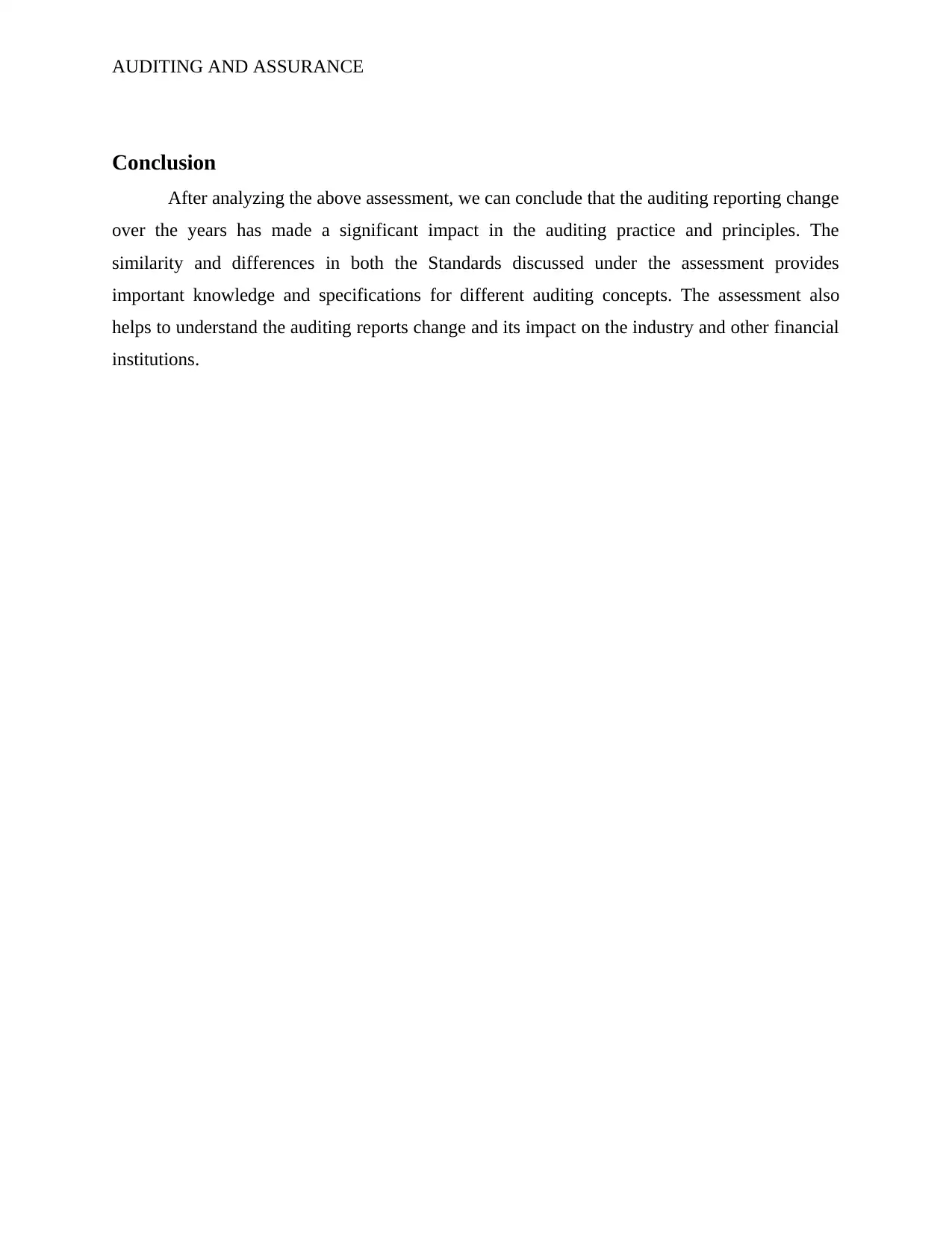
AUDITING AND ASSURANCE
Conclusion
After analyzing the above assessment, we can conclude that the auditing reporting change
over the years has made a significant impact in the auditing practice and principles. The
similarity and differences in both the Standards discussed under the assessment provides
important knowledge and specifications for different auditing concepts. The assessment also
helps to understand the auditing reports change and its impact on the industry and other financial
institutions.
Conclusion
After analyzing the above assessment, we can conclude that the auditing reporting change
over the years has made a significant impact in the auditing practice and principles. The
similarity and differences in both the Standards discussed under the assessment provides
important knowledge and specifications for different auditing concepts. The assessment also
helps to understand the auditing reports change and its impact on the industry and other financial
institutions.
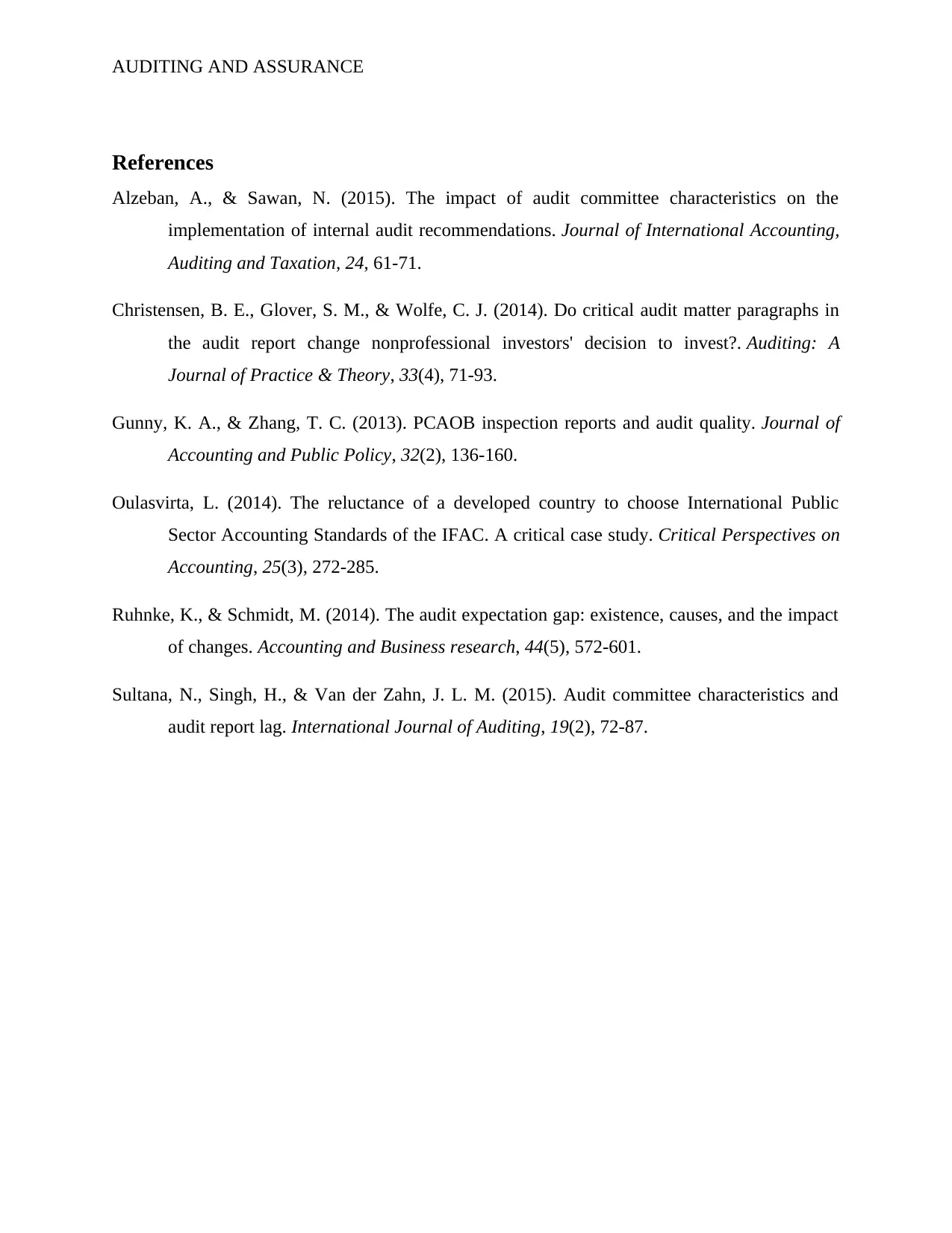
AUDITING AND ASSURANCE
References
Alzeban, A., & Sawan, N. (2015). The impact of audit committee characteristics on the
implementation of internal audit recommendations. Journal of International Accounting,
Auditing and Taxation, 24, 61-71.
Christensen, B. E., Glover, S. M., & Wolfe, C. J. (2014). Do critical audit matter paragraphs in
the audit report change nonprofessional investors' decision to invest?. Auditing: A
Journal of Practice & Theory, 33(4), 71-93.
Gunny, K. A., & Zhang, T. C. (2013). PCAOB inspection reports and audit quality. Journal of
Accounting and Public Policy, 32(2), 136-160.
Oulasvirta, L. (2014). The reluctance of a developed country to choose International Public
Sector Accounting Standards of the IFAC. A critical case study. Critical Perspectives on
Accounting, 25(3), 272-285.
Ruhnke, K., & Schmidt, M. (2014). The audit expectation gap: existence, causes, and the impact
of changes. Accounting and Business research, 44(5), 572-601.
Sultana, N., Singh, H., & Van der Zahn, J. L. M. (2015). Audit committee characteristics and
audit report lag. International Journal of Auditing, 19(2), 72-87.
References
Alzeban, A., & Sawan, N. (2015). The impact of audit committee characteristics on the
implementation of internal audit recommendations. Journal of International Accounting,
Auditing and Taxation, 24, 61-71.
Christensen, B. E., Glover, S. M., & Wolfe, C. J. (2014). Do critical audit matter paragraphs in
the audit report change nonprofessional investors' decision to invest?. Auditing: A
Journal of Practice & Theory, 33(4), 71-93.
Gunny, K. A., & Zhang, T. C. (2013). PCAOB inspection reports and audit quality. Journal of
Accounting and Public Policy, 32(2), 136-160.
Oulasvirta, L. (2014). The reluctance of a developed country to choose International Public
Sector Accounting Standards of the IFAC. A critical case study. Critical Perspectives on
Accounting, 25(3), 272-285.
Ruhnke, K., & Schmidt, M. (2014). The audit expectation gap: existence, causes, and the impact
of changes. Accounting and Business research, 44(5), 572-601.
Sultana, N., Singh, H., & Van der Zahn, J. L. M. (2015). Audit committee characteristics and
audit report lag. International Journal of Auditing, 19(2), 72-87.
⊘ This is a preview!⊘
Do you want full access?
Subscribe today to unlock all pages.

Trusted by 1+ million students worldwide
1 out of 9
Related Documents
Your All-in-One AI-Powered Toolkit for Academic Success.
+13062052269
info@desklib.com
Available 24*7 on WhatsApp / Email
![[object Object]](/_next/static/media/star-bottom.7253800d.svg)
Unlock your academic potential
Copyright © 2020–2025 A2Z Services. All Rights Reserved. Developed and managed by ZUCOL.




